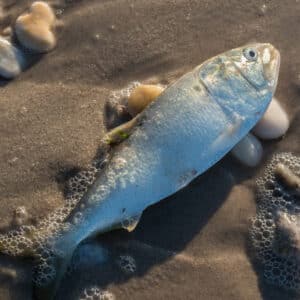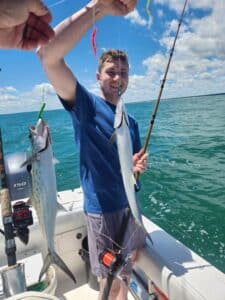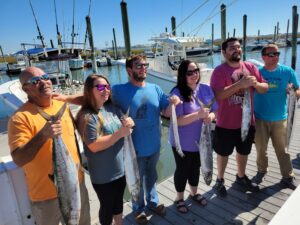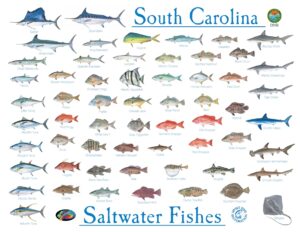How to Identify Spanish Mackerel: An Angler’s Guide to Fishing Murrells Inlet
At Fish Finder Fishing Charters, we pride ourselves on helping anglers of all levels reel in the catch of a lifetime. One of the most popular and exciting species to target is the Spanish mackerel (Scomberomorus maculatus). Known for their speed and agility, these fish are a thrill to catch. In this blog, we’ll provide you with essential tips on how to identify Spanish mackerel, including their habits, habitats, seasonal patterns, bait choices, and some intriguing scientific facts.
Identifying Spanish Mackerel
Spanish mackerel are easily recognized by their distinctive features:
- Size: Spanish mackerel are generally smaller than their cousins, the king mackerel. They typically range from 2 to 6 pounds, with some reaching up to 12 pounds.
- Color: These fish have a greenish-blue back, which fades to silvery sides and a white belly. The sides are adorned with yellow or olive-green oval spots.
- Dorsal Fin: The first dorsal fin is black with a prominent dip in the middle.
- Lateral Line: Unlike king mackerel, the lateral line of a Spanish mackerel gently curves down toward the tail.
Habits and Habitats
Spanish mackerel are found along the Atlantic coast of the United States and the Gulf of Mexico. Understanding their habits and preferred habitats can significantly enhance your fishing experience:
- Habitat: Spanish mackerel thrive in coastal waters, often within a mile or two of the shore. They prefer depths of 10 to 50 feet and are commonly found around piers, jetties, and reefs.
- Behavior: These fish are fast swimmers and aggressive feeders, often hunting in schools. They feed on small fish, shrimp, and squid, striking quickly and frequently.
Seasonal Patterns
The movement of Spanish mackerel is influenced by water temperature and the availability of food. Here’s what you need to know about their seasonal patterns:
- Spring: As the water warms, Spanish mackerel migrate northward along the coast. This is an excellent time to target them as they are actively feeding.
- Summer: During the summer months, they are abundant and widely distributed, making it the prime season for fishing.
- Fall: As temperatures begin to drop, they migrate southward. Fall provides another opportunity to catch them in nearshore waters.
- Winter: In the winter, Spanish mackerel are found in the warmer waters of the southernmost parts of their range.
Bait Choices
Using the right bait is crucial for a successful Spanish mackerel fishing trip. Here are some top bait choices:
- Live Bait: Live shrimp, small menhaden, and small mullet are excellent choices. Their natural movement attracts the quick and agile Spanish mackerel.
- Dead Bait: Cut bait, such as strips of squid or mullet, can also be effective, especially when fished on a fast retrieve.
- Lures: Spanish mackerel are attracted to shiny, fast-moving lures. Silver spoons, small jigs, and flashy plugs are great options. Trolling these lures at high speeds can produce impressive results.

Scientific Facts
To round out our guide, here are some fascinating scientific facts about Spanish mackerel:
- Lifespan: Spanish mackerel can live up to 12 years, though their average lifespan is around 5 to 8 years.
- Growth Rate: These fish grow quickly, reaching up to 12 inches in their first year.
- Reproduction: Spawning occurs from April to September, with peak activity in the summer months. Females can release up to 1.5 million eggs per season.
- Diet: Their diet primarily consists of small fish, shrimp, and squid, making them opportunistic feeders that strike at a variety of prey.

By understanding how to identify Spanish mackerel and knowing their habits, habitats, seasonal patterns, and Regulations you can greatly improve your chances of a successful fishing trip. Whether you prefer using live bait, dead bait, or lures, targeting these fast and aggressive fish can provide an exhilarating experience.
Book your next fishing adventure with Fish Finder Fishing Charters, and let us help you catch these exciting fish. Tight lines and happy fishing!
For more tips and to book your charter, visit our website or contact us directly. We’re here to make your fishing dreams come true!





